2008 Dodge Challenger SRT8 Review
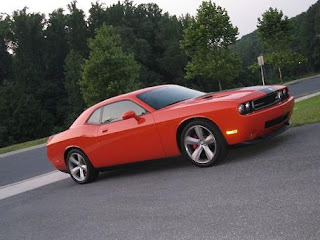 If you want to keep a low profile and not attract attention, the Challenger is not the car for you. If conservation of natural resources is a priority, there are far better choices than the Challenger. If your needs require a spacious interior with easy access to all seating positions, move along to the next review.
If you want to keep a low profile and not attract attention, the Challenger is not the car for you. If conservation of natural resources is a priority, there are far better choices than the Challenger. If your needs require a spacious interior with easy access to all seating positions, move along to the next review.
That being said, if you enjoy discussing your car with strangers (and getting thumbs-up signs and waves from people of all walks of life), if you put a premium on performance over efficiency, and if you will usually only use the two front seats, the Dodge Challenger SRT8 might be just what you need. Especially when the car is Hemi Orange.
After having driven a Challenger SRT8 for a long weekend, courtesy of Chrysler, it will be hard to forget some memorable moments. The afternoon the car arrived, our neighbor asked my wife where I got a Challenger, saying that he had been looking for one at local dealers to check out, but couldn’t find one anywhere. He also insisted on a ride, which I gave him later that evening. Following that, I took it to the grocery store. As I was locking the car, a woman in her late-40s said, “that’s a beautiful car.” On my way home from the store, I had the windows down and was at a traffic light in town, and a man across the street yelled, “Yo man, that’s a TIGHT ride!” Two days later, en route to my parents’ house, a man in a minivan followed me from their town square to their house to ask about the car. Later that afternoon, a man actually parked his car across the street and rang my parents’ doorbell just to talk about the car. Several motorcyclists gave me the hand-down wave they usually reserve for fellow bikers when they encountered me traveling in the opposite direction. The man from the fleet vendor who dropped off the car did warn my wife people would stop us to ask about it – he was right.
So, the Challenger has the ability, at least as a new model, to make you feel like a B-list or C-list celebrity. To me, that beats the anonymity I usually experience in an Accord, or even worse – the anonymity that I’m experiencing this week testing a Kia Sportage.
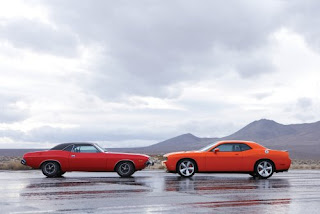 The Challenger is obviously an interesting vehicle to look at. Without having a 1970 Challenger on hand for reference, its exterior looks almost like it leapt right out of the early 1970s, but was lowered a few inches, updated for modern times with gigantic 20 inch aluminum wheels and body colored, integrated bumpers. Comparing some dimensions between the 1970 and 2008 models, the 1970 model is far lower, but also wider. The 2008 model stays true to the 1970 model’s overall styling theme, with the shape of its rear quarter window and upturned character line aft of the doors, but has a shorter greenhouse (plus a fixed B-pillar for side impact and structural rigidity reasons), along with some added aero tricks such as a flat black chin spoiler and tasteful flat black decklid spoiler, which, according to Chrysler, allow the car to keep its stability at triple digit speeds. It’s interesting how the car appears to sit so low to the ground, but is actually quite tall. A very cool retro touch is the chrome gas cap, which looks very much right out of the 1970s, but functionally is just a standard fuel filler door, hiding a standard plastic screw-on gas cap. By the way, premium unleaded is recommended.
The Challenger is obviously an interesting vehicle to look at. Without having a 1970 Challenger on hand for reference, its exterior looks almost like it leapt right out of the early 1970s, but was lowered a few inches, updated for modern times with gigantic 20 inch aluminum wheels and body colored, integrated bumpers. Comparing some dimensions between the 1970 and 2008 models, the 1970 model is far lower, but also wider. The 2008 model stays true to the 1970 model’s overall styling theme, with the shape of its rear quarter window and upturned character line aft of the doors, but has a shorter greenhouse (plus a fixed B-pillar for side impact and structural rigidity reasons), along with some added aero tricks such as a flat black chin spoiler and tasteful flat black decklid spoiler, which, according to Chrysler, allow the car to keep its stability at triple digit speeds. It’s interesting how the car appears to sit so low to the ground, but is actually quite tall. A very cool retro touch is the chrome gas cap, which looks very much right out of the 1970s, but functionally is just a standard fuel filler door, hiding a standard plastic screw-on gas cap. By the way, premium unleaded is recommended.
 Inside, it’s a different story. You can tell you’re not in 1970 the minute you open the door. Actually, before you open the door, as you begin to lift the handle, the indexed window drops down a quarter inch to make it easier for the doors to open, yet allow an airtight seal once the door is closed. The front seats are well-bolstered and very comfortable, as long as you aren’t of very large stature and don’t mind being hugged by your seat, both on your legs and your back. My wife found the front passenger seat uncomfortable (she’s slender, too), but I spent a lot more time in the car than she did, and I had no issues with seat comfort. The seats are covered by Alcantara (synthetic suede) on the seating surfaces, and with leather on the bolsters and headrests. Alcantara also covers the door panel inserts. The dashboard itself is soft to the touch, although its texture and dark charcoal appearance are somewhat low-grade. There is carbon fiber-looking plastic surrounding the center stack (HVAC and audio/navigation controls) to lend a somewhat sporty appearance, and chrome plated plastic can be found in the area around the gearshift lever and on the door handles, as well as surrounding the gauges. It’s kind of disappointing that Chrysler did not give the interior as much personality as the car’s exterior. Although many parts are shared with the Challenger’s LX platform mates, the dash is a unique design, and could have been much more interestingly designed.
Inside, it’s a different story. You can tell you’re not in 1970 the minute you open the door. Actually, before you open the door, as you begin to lift the handle, the indexed window drops down a quarter inch to make it easier for the doors to open, yet allow an airtight seal once the door is closed. The front seats are well-bolstered and very comfortable, as long as you aren’t of very large stature and don’t mind being hugged by your seat, both on your legs and your back. My wife found the front passenger seat uncomfortable (she’s slender, too), but I spent a lot more time in the car than she did, and I had no issues with seat comfort. The seats are covered by Alcantara (synthetic suede) on the seating surfaces, and with leather on the bolsters and headrests. Alcantara also covers the door panel inserts. The dashboard itself is soft to the touch, although its texture and dark charcoal appearance are somewhat low-grade. There is carbon fiber-looking plastic surrounding the center stack (HVAC and audio/navigation controls) to lend a somewhat sporty appearance, and chrome plated plastic can be found in the area around the gearshift lever and on the door handles, as well as surrounding the gauges. It’s kind of disappointing that Chrysler did not give the interior as much personality as the car’s exterior. Although many parts are shared with the Challenger’s LX platform mates, the dash is a unique design, and could have been much more interestingly designed.
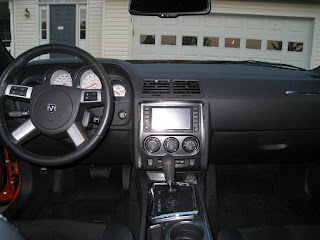 The Challenger has standard keyless pushbutton start, allowing you to start and operate the car with the key fob in your pocket, but does not have a key-free/fob-free way to enter the car as some competitors such as Toyota and Nissan have. Instead, you have to unlock the doors the semi-old-fashioned way (clicking a button on the remote fob), then stuff the key back into your pocket. Once settled into the car, the startup routine is as simple as holding your foot on the brake pedal and tapping the Start/Stop button. With that, the 6.1 liter Hemi V8 fires into action, and settles into a deep, lusty bass rumble. I’m sure the kids up the street from me were scared every time I started it.
The Challenger has standard keyless pushbutton start, allowing you to start and operate the car with the key fob in your pocket, but does not have a key-free/fob-free way to enter the car as some competitors such as Toyota and Nissan have. Instead, you have to unlock the doors the semi-old-fashioned way (clicking a button on the remote fob), then stuff the key back into your pocket. Once settled into the car, the startup routine is as simple as holding your foot on the brake pedal and tapping the Start/Stop button. With that, the 6.1 liter Hemi V8 fires into action, and settles into a deep, lusty bass rumble. I’m sure the kids up the street from me were scared every time I started it.
The steering wheel is right out of the Chrysler parts bin (aside from some detail differences, it’s the same as the one in the Magnum, Charger, and 300C), but has a carbon fiber-like appearance in the top section of leather. That appearance is carried over onto the leather wrap on the gearshift knob. Once the car is in gear, forward visibility is fairly good (though the retro-length hood is quite a bit longer than the hoods of most other new cars. Lateral visibility is also decent, but the huge C-pillars and short backlight create real difficulties in backing up safely. Since the navigation screen/head unit is apparently the same one available in the Chrysler Town & Country, and that same unit can work with a backup camera in the T&C, maybe it wouldn’t be a bad idea for Chrysler to hide a small camera somewhere in the rear of the car to eliminate blind areas when backing up the car.
The interior is fairly roomy if you’re only using the front seats. The back seat is adequately wide, but legroom suffers significantly relative to the 300C and Charger, because the Challenger’s wheelbase is four inches shorter (and consequently rear seat legroom is eight inches shorter than it is in the Charger. Trying to squeeze to car seats into the back seat would have been significantly easier if there were another eight inches of clearance, although I’m fully aware that the car’s outstanding proportions would have been ruined with the sedan’s longer wheelbase. We did manage to get the seats into the car, although getting the little ones into those seats was another challenge (is that why they call the car the ‘Challenger’?) To put a sleeping seven month old into his rear-facing seat, I had to thread him between the front seats, onto his spot. Surprisingly, he stayed asleep, and didn’t really mind riding back there. When tilting the front seatbacks forward for rear seat access, they do not slide forward automatically, and the seatback angle is reset to the most-upright position when the seat is returned to upright. Although those front seats are large, comfortable, and supportive, the tilt/slide mechanism really could have used some improvement; the 1993 Oldsmobile Achieva SCX I owned during my college years didn’t even suffer the same annoyance.
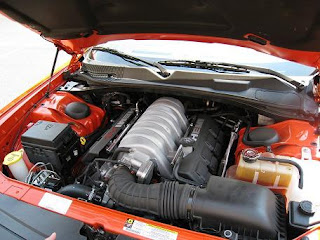 Acceleration with a 425 horsepower, 420 lb-ft, 6.1 liter Hemi is, of course, instantaneous. The powerful engine does a great job of disguising the car’s fairly considerable mass, because so many horsepower are working toward the cause of moving the big guy. Published road tests for the Challenger SRT8 show fairly consistent 0-60 times of 4.7 seconds and a quarter mile of about 13 seconds at about 109 miles per hour. I wasn’t brave enough (or couldn’t find a safe spot to try) the quarter mile acceleration test, but the car has a performance mode on the digital instrument cluster that will give 0-60, 1/8 mile, 1/4 mile, 60-0 braking, peak g-forces, and more. The best 0-60 I could manage was 5.0 flat, but traction control stayed on, I had a passenger, and I didn’t power brake (release brake, depress gas, and go). Oh, and it was slightly downhill. I’ve heard that the performance metrics on these built-in computers aren’t very accurate compared to the GPS-verified used by the mainstream automotive media, so I’m taking that number with a grain of salt anyway, but it is a pretty cool thing to have.
Acceleration with a 425 horsepower, 420 lb-ft, 6.1 liter Hemi is, of course, instantaneous. The powerful engine does a great job of disguising the car’s fairly considerable mass, because so many horsepower are working toward the cause of moving the big guy. Published road tests for the Challenger SRT8 show fairly consistent 0-60 times of 4.7 seconds and a quarter mile of about 13 seconds at about 109 miles per hour. I wasn’t brave enough (or couldn’t find a safe spot to try) the quarter mile acceleration test, but the car has a performance mode on the digital instrument cluster that will give 0-60, 1/8 mile, 1/4 mile, 60-0 braking, peak g-forces, and more. The best 0-60 I could manage was 5.0 flat, but traction control stayed on, I had a passenger, and I didn’t power brake (release brake, depress gas, and go). Oh, and it was slightly downhill. I’ve heard that the performance metrics on these built-in computers aren’t very accurate compared to the GPS-verified used by the mainstream automotive media, so I’m taking that number with a grain of salt anyway, but it is a pretty cool thing to have.
The Challenger SRT8 comes with outstanding Brembo brakes that bring the fun to a brisk halt if called upon. Having some quick, yet safe, fun with the car on a back road with tight curves, the brakes never showed any sign of fade or fatigue. The red calipers also add a bit more visual spice to the exterior. The only problem with great brakes is that they generally produce more brake dust marring the aluminum wheels; in spite of most of my time with the Challenger being on the highway with my family, in about 400 miles with the car, the wheels started to get pretty dirty.
Helping not only the aforementioned braking, but also steering, were the huge 20 inch, 45-series Goodyear Eagle F1 Supercar tires (255/45ZR-20 in the rear; 245/45ZR-20 in the front). The tires are considered “three season” (summer) tires, and are grippier in dry conditions than the standard all-season rubber, but completely inappropriate in winter (as if a 425-horsepower rear wheel drive muscle car would otherwise be appropriate in the snow).
The exhaust note is absolutely intoxicating from about 3,500 RPMs to 5,000, and I found myself tempted to manually keep the car in a lower gear than necessary just to hear the roar of the big V8. My wife reported (via frequent scolding) that the exhaust that sounded so great to me from the driver’s seat was a bit booming in the back seat where our sons were riding. Although I spent most of my lower-speed driving with the windows down and sunroof open, the car is actually quite sedate with everything closed. When the boys were sleeping for a long stretch, I referred to the car as a “pussy cat” more than once. Driven gently, the Challenger SRT8 emits just a serene purr from the engine compartment that sounded not unlike the more pedestrian 5.7 liter Hemi in the Chrysler 300C that I tested a few months ago. But, kick the five-speed automatic down a few gears, and it barks with a ferocity seen in few modern vehicles. It was almost a Jekyll-and-Hyde dichotomy, completely under the control of my right foot. My only complaint about the driving experience is that the automatic does not hold your gear choice up to the rev limited when in AutoStick (manual) mode; instead, it holds on until the redline, then upshifts. So, if you know a corner is coming soon and want to keep the car in a lower gear to blast out of the corner, you’ll have to either back off the gas a bit so the car doesn’t upshift itself, or downshift mid-corner (a potentially risky move). Or, you could wait for the 2009 model year and buy a six-speed manual, which will cost about $1,000 extra, but will be the beefy Tremec 6060 used in the 600 horsepower Viper SRT10.
Unsurprisingly, I barely turned the stereo on, but it’s an impressive one. It is a 13-speaker Kicker system with a 322-watt amplifier and 200-watt subwoofer that resides on the left side of the trunk. As with the V8 underhood, the stereo had an overabundance of power. The trunk was also quite spacious, leaving plenty of space to carry as much as two empty-nesters (who could afford to buy and feed this car) would need for a weeklong vacation. As a bonus, the lid was supported by gas shocks and not the cheaper gooseneck hinges found in some cars; as a result, there is no risk that the contents of the trunk will be crushed when closing the lid.
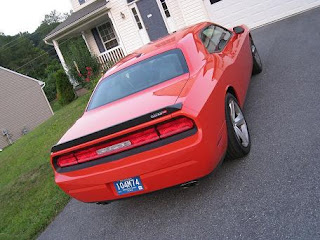 As mentioned in the opening sentences of this review, if you’re looking for fuel economy, look elsewhere. The EPA rates the Challenger SRT8 at 13 city/18 highway. The 6.1 liter SRT-massaged version of Chrysler’s Hemi V8 does not include variable displacement technology to shut down four of the cylinders under light load condition, which really helped the 300C AWD on the highway. However, gentle driving and setting the cruise control at 72 miles per hour on the highway yielded a relatively impressive 19.2 miles per gallon according to the car. However, it also cost me $46 to bring the tank back up to almost-full of premium after about 200 miles, including that aforementioned “economical” highway trip. Overall, my mileage was about 17 miles per gallon, which came from about 80% highway and 20% city mileage. That’s about what I got from the 300C AWD, but the Challenger had the luxury of far more highway miles than did the 300C.
As mentioned in the opening sentences of this review, if you’re looking for fuel economy, look elsewhere. The EPA rates the Challenger SRT8 at 13 city/18 highway. The 6.1 liter SRT-massaged version of Chrysler’s Hemi V8 does not include variable displacement technology to shut down four of the cylinders under light load condition, which really helped the 300C AWD on the highway. However, gentle driving and setting the cruise control at 72 miles per hour on the highway yielded a relatively impressive 19.2 miles per gallon according to the car. However, it also cost me $46 to bring the tank back up to almost-full of premium after about 200 miles, including that aforementioned “economical” highway trip. Overall, my mileage was about 17 miles per gallon, which came from about 80% highway and 20% city mileage. That’s about what I got from the 300C AWD, but the Challenger had the luxury of far more highway miles than did the 300C.
The base price for the 2008 Challenger SRT8 is $37,320. My test vehicle included every available option, including the (mandatory) gas guzzler tax ($2,100), power sunroof ($950), MyGIG system with navigation ($890), and summer tires ($50). Chrysler actually does not charge a destination fee, which is impressive since many manufacturers are actually increasing their destination charges in this time of high fuel prices. The final tally was $41,310 – if you can get a dealer to sell one to you for MSRP. The original party line was that the entire 2008 production run of 6,400 cars was sold out, but as of this writing, there were stories that some Dodge dealers had multiple examples in stock, so if you want a 2008 model, do some research and shopping around. The advantage of a 2009 model will be the availability of an optional six-speed manual transmission with pistol grip shifter, plus a mechanical limited slip differential (the 2008 model has an electronic limited slip differential, which isn’t quite the same). Aside from fuel economy, pricing, and safety (it has standard stability control and side airbags, plus seatbelt pretensioners and seatbelt force limiters), the only other consumer-related item to mention is that the SRT models do NOT include Chrysler’s lifetime powertrain warranty. Instead, the powertrain falls under the same 3 year/36,000 mile basic limited warranty that covers the rest of the car.
It really was an awesome feeling to spend a long weekend with the Challenger. It was one of the rare cars that was very difficult for me to give back, although it would have probably cost me half of an extra car payment’s worth of money to fuel the car often enough for daily driving. But the feeling of having seemingly limitless power underfoot, plus the feeling that the orange car you’re driving around is making other people smile at you, really has a lot of value for some folks. My empty nester, baby boomer father loved the Challenger, and he’s a classic car/modern truck guy at heart. As Ferris Bueller memorably said in 1986, “It is so choice. If you have the means, I highly recommend picking one up.” Truer words have not been spoken. The Challenger is a sweet ride, and I feel privileged to have had a chance to enjoy it firsthand.




